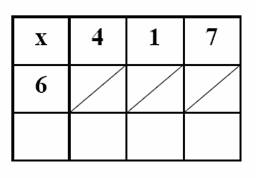Procedure:
- Student writes the problem in the grid (e.g. 6 x 417).
- Student then writes the answer to each single digit multiplication in the appropriate square.
- The tens digit is placed above the diagonal; the ones digit below the diagonal.
- When all squares have been completed, the student sums the numbers between each set of diagonals, and writes the sum at the bottom of the grid. NOTE: If the sum is greater than 10, regroup the ten to the next diagonal to the left.
- The student can now simply read the answer from left to right and insert commas, as appropriate.
For a complete overview of this method, see Cool Math's explanation of Lattice Multiplication to view the step-by-step procedure. Take a cue from the site's explanation and use colored markers when introducing this algorithm to students on the overhead or whiteboard.
Practice:
- Download Lattice Multiplication for a practice page.
- Download Lattice Multiplication Answers for answers to the practice page.
- Download the Lattice grids for a single digit multiplier.
- Download the Lattice grid for a 2-digit multiplier.
- Download the Lattice grid for 2-3 digit multipliers.




I love the simplicity of this algorithm, which I teach as "Napier's Bones". Students seem to love the way it leads them pretty directly to the answer, without a lot of having to line digits up and remember where to put everything. Thanks for sharing, TK!
ReplyDeleteI also love the algorithm and plan to highlight Napier's Bones this week. My students always loved using Napier's Bones as if they'd discovered some magic math trick!
ReplyDelete